Featured Stories
Fern Street Circus: Homegrown Circus Is Revived for Its 25th Anniversary
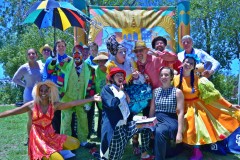
Cast of the Fern Street Circus
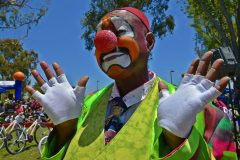
Otis the clown (Garry Irvingwhite)
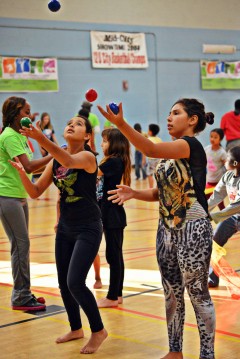
Students learn to juggle
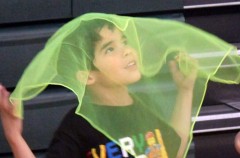
Scarf juggling. Photo by Sneha Craig.
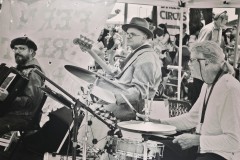
Fern Street Melody Makers: Garry Irvingwhite, John Highkin, David Page
I don’t believe that I’ve ever run across the words “office” and “circus” in the same sentence. But if you think about it, looking after a team of aerial artists and jugglers needs some sort of administrative support. Somebody has to sit at a desk and look after the accounting books and schedules for those colorful acts.
Yes, even clowns need to have admin support.
So, recently I found myself in the offices of the Fern Street Circus, the performance ensemble that is celebrating its 25th anniversary of offering Southern California our own homegrown circus. Posters of ochre, red, and blue, with images of acrobats and stilt walkers, all from past performances of the Fern Street Circus, fill the walls as I sit down to talk to John Highkin and Mark Danisovszky. Over coffee and a refreshing glass of water on a hot day they tell me of the circus and its recent revival after years of a hiatus.
There is no laser show at the Fern Street Circus. You won’t see lions or elephants either. In some ways this performance unit is what a circus may have been like generations ago. It is a simpler aesthetic, built around the creativity of all those involved in the circus. Highkin says, “We’re low tech. It’s dictated by where we are performing and why, which is in city parks during the daytime. It’s more on a human scale than what you’ve seen in the big top.”
The skill level of the performers ranges from youngsters honing their skills to seasoned performers, some of whom have been with the Fern Street Circus since that first performance back in 1990. Some of Fern Street performers of are veterans of Cirque de Soleil.
Highkin and his wife, Cindy Zimmerman, started the circus back in 1990. The big tents of Barnum and Bailey and the lions and tigers of Ringling Brothers were not what the couple had in mind. They wanted to create something akin to the Pickle Family Circus, a San Francisco-based organization that developed out of the San Francisco Mime Troup. The Pickle Family Circus’ move away from the three-ring extravaganza and eschewing of animal performers also influenced the development of Circ de sol.
Good-natured and upbeat, Highkin is earnest as he speaks, like the high school guidance councilor who urged you to take algebra instead of shop, so you could get into college. He’s a baby boomer, but still has a full head of hair. “My role model is Bertold Brecht,” he says behind a pair of round owlish eyeglasses that were favored by the German poet and playwright who broke social conventions with such works as The Threepenny Opera. Danisovszky is the more measured of the two. Bearded with longish hair, he seems to add stability and keep at least part of the goings on of the circus grounded. A professional accordionist, pianist, and composer, Danisovszky was there with Highkin and Zimmerman at the beginning of the Fern Street Circus, serving as the musical director for the circus.
Like the Pickle Family Circus, all of the Fern Street Circus performances tell a story. Highkin says, “Our first year, what we told was the story of slavery in San Diego. We were trying to tell a very detailed story, which was very impractical. What you’re relying on in a circus setting are physical metaphors. When you’re telling a story outdoors, you have to develop a nonlinear narrative, one that, as an audience member, you don’t have to follow from segment to segment. In our second year we did the story of Frogzilla!” Highkin’s eyes brighten up
as he remembers the costumes and
whimsical story.
Danisovszky adds, “What we have to deal with is an issue of complexity. We have in our audience little kids. We have to appeal to those small children, and
we have to appeal to their grandparents as well.”
“Having a loose, nonlinear narrative is better for us,” says Highkin. “In this format, being told everything about the story is disengaging for audience members. People like it better if they have to get the story from other clues such as costuming and music. Besides a story, what we’re trying to create with circus is a sense of place. Circus is also vibrant and can serve as a critique of social
institutions.”
Both Highkin and Danisovszky agree that music is the backbone of any circus. Six or seven years ago the Fern Street Circus started using recorded music as part of their performances, but Danisovszky anticipates bringing live music back to the performances. “We use some previously composed music, but a lot of the music that we perform as part of the circus arises out of the performers themselves,” he says.
Highkin, who also goes by the moniker Johnny High-Hat, studied English at Cambridge, with the intent of working in the performing arts. He has also been a bluegrass musician, playing the mandolin, banjo, and doghouse bass. In 2003 Highkin left the Fern Street Circus and San Diego to go back into music, pursuing politics as also being a possibility. The circus carried on, but without the vision of Highkin and Zimmerman, it faltered. The last performance of the Fern Street Circus was in 2010. In 2011, the circus’ board of directors voted to close up shop on the organization.
Last year, with full dissolution of the circus only weeks away, Highkin told Laura Stansell, the circus’s executive director at the time, that he was interested in getting the circus going again. A great deal of the assets of the circus had been sold off to pay old debts; so the organization has little in way of props or equipment that it had built up over the years. “In a lot of ways, we’re starting from scratch,” says Highkin. “ But much of the Circus is the same. We have a lot of the same people. There’s Garry O. Irvingwhite, who has been with the circus from the beginning, and Cheryl Lindley. Gary is the clown Otis and Cheryl is Columbina. They do lots of routines together.”
Fern Street is the original and only social circus in San Diego. An idea promoted by Cirque de Soleil, social circus is a way of using the performing arts associated with circus, all the juggling, acrobatics, and even being a clown, as a means of social intervention and changing communities. Teaching youngsters to master a pair of stilts or to engage a large crowd while wearing oversized shoes and wearing greasepaint is intended to enhance their self-esteem and help them with their personal and social development.
The Fern Street Circus is known for these programs for children almost as much as they are known for their clowns and jugglers. The Circus Youth Apprentice Program is available to students in Golden Hill and other neighborhood schools, children learn all aspects of putting on a show, everything from applying greasepaint, to walking on stilts. The two month long program culminates in performances in front of live audiences.
Folks who spent their childhood or at least part of their childhood performing in the Fern Street Circus speak of this experience as helping them now in their adult lives and careers. Wade Green, who was a juggler and musician in the Fern Street Circus, says that he opened up and lost the shyness that plagued him as a child and adolescent when he performed with the circus. He is now a football coach at the U.S. Military Academy Prep School. Pamela Gonzales was an aerialist and is now a diplomat in Brazil. She was recently discussing the implementation of an arts program similar to her Fern Street experience to help drug addicts in a Sao Paolo slum.
The theme for this year’s Fern Street Circus is The Adventures of Heart Man, and Highkin shows me the star of the show. In what would otherwise be an office hangs a huge amalgamation of red cloth, wood and wires. Arms and legs emanate from a huge heart. Black patches of material form eyes and a mouth, and Highkin shows me how the expression of the puppet goes from a smile, to a frown, to a large O of astonishment. More than one person operates the huge animated object. Highkin says, “The Adventures of Heart Man, the whole story is an examination of why we need heros.”
As I leave Fern Street’s offices, I speak to Sneha Craig, who has been quietly at her desk and working on her computer. She does administrative support for the circus. “Oh, but I get into costume in the circus, too,” she tells me.
I guess even the folks in the office need to get into the act when it’s the Fern Street Circus.





